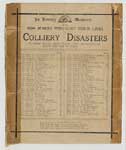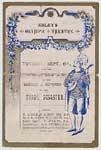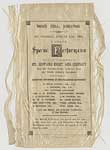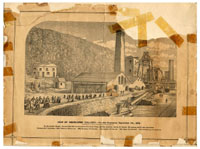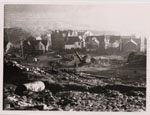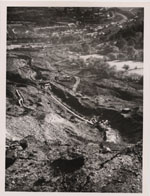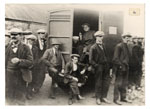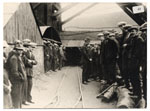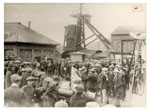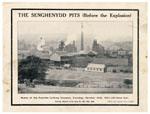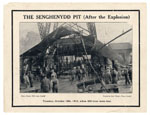 |
| You are here: Cwm > Themes > Love and hate > : Disasters | |
 | |
|
Disasters |
|
|
|
|
|
Prince of Wales Colliery | Aberfan | Milfraen Colliery | Universal Colliery | Lewis Merthry Colliery The collieries of South Wales were dangerous places to work. Apart from physically breathing in dust and fumes, the miner continually worked in the shadow of dangers such as gas explosions, colliery floods, roof falls or injury from machinery such as being crushed by drams. Miners quickly learnt how to read the sounds of the mine: listening for cracking roof beams, shifting timber, the running of rats or warnings from workmates: any signal that could mean there had been a fall, an explosion or that danger was imminent. |
|
|
Such incidents could result in crippling injuries or at worst , death. Thus families lived with the constant fear that their menfolk, be they husbands, fathers, sons or brothers would not return from their daily work. It is estimated that in British mines between 1868 and 1914 an average of one miner was killed every six hours and 12 were injured daily. The portable theatre became common in Wales after the passing of the Theatres act 1843, declining by 1914 with the onset of the First World War. The theatres, as their name suggests, could be dismantled and moved easily. The theatres were very popular and well supported in the small towns and villages that they visited. Edward Ebley`s 'Theatre of Varieties' was one particularly popular company and as can be seen from the examples of playbills below, gave perfomances in aid of colliery disasters such as the Tondu disaster and the Garth Colliery Accident.
If you would like to discover more about the Portable Theatre in South Wales other material can be looked at in the Archives including correspondence and playbills.
|
|
|
Prince of Wales Colliery, Abercarn.
Rescue teams were lowered into the colliery to be confronted by smoke, fires, afterdamp and the
131 widows Pamphlets relating to this disaster can be found at the South Wales Miners' Library.
|
|
|
Aberfan, 1966. The Aberfan disaster occurred at 9:15am on Friday October 21st 1966. Coal waste from the mountain above the village rushed down the mountain, first destroying a cottage, and then engulfing the school and some houses in the village. 144 people were killed including half the children in the school and five of their teachers. The cause was an underground spring, and two days of heavy rain which caused the coal waste on the mountain to loosen. A mass funeral was held on the 25th October, and the children buried on the hillside. A disaster fund was launched, and it collected over £1 million in the four months it was open. Some money went to the families, and towards house repairs, a community hall, and a memorial. As the National Coal Board refused to accept full financial responsibility for the disaster, money from the fund had to contribute towards the removal of the remaining tips overlooking the village. This money was not refunded until 1997. As a result of the disaster, The Mines and Quarries (Tips) Act 1969 was passed, which states it is 'An Act to make further provision in relation to tips associated with mines and quarries; to prevent disused tips constituting a danger to members of the public; and for purposes connected with those matters'. The requirements to comply with this act are laid out in The Mines and Quarries (Tips) Regulations 1971. The archives also hold disaster fund correspondence and lists of donations to the fund whilst the South Wales |
|
|
Milfraen Colliery Disaster, 10th July 1929 The Milfraen Colliery was owned by the Blaenavon Company Ltd and was situated to the north -west of Blaenavon. At 8.30am on Wednesday 10th July 1929, in an area called 'Mapstones', a gas explosion occurred which resulted in the loss of 9 lives. The rescue station at Crumlin attended and the last body was removed from the colliery at 5.00pm. In his report to parliament Mr. J. Macleod Carey, H.M. Divisional Inspector of Mines, concluded that the explosion was caused by "sparking at the switch within the electric coal cutting machine: and owing to the defective condition of the cover of that machine, flame was emitted and ignited gas outside the machine.". A report of the colliery disaster is held in the South Wales Miners' Library. This series of photographs are of the Milfraen Colliery at the time of the Milfraen Disaster. Photographs show miners, friends and families awaiting news concerning those injured in the disaster. |
|
|
Universal Colliery, Senghenydd. Tragedy struck the people of Senghenydd twice with the disasters happening within 12 years of each other. The first disaster occurred on the 24th May 1901 when firedamp ignited and resulted in the deaths of 82 men, all from the village of Senghenydd. However it was the disaster of October 14th 1913 that was particularly horrific involving the loss of 439 men. The explosion occurred at 8.10am with the underground force of the blast destroyingthe pithead and winding gear above ground. Rescue teams from the Rhymney Valley (see picture), Crumlin, Aberdare and Porth all entered the pit, themselves facing dangers such as the roof fall that killed rescuer William John of Aberdare.The Inquest verdict was one of "Accidental Death" but a Government Inquiry found a disregard for safety and the Coal Mines Act by the Owners. On April 1914 the manager himself was found guilty of 5 charges and fined £25, however 17 charges against the owners were dismissed. Following pressure by the Miners` Federation, a charge was brought against the Colliery company and in February 1916, they were fined £10 with £5 5s costs.1 The human costs of the tragedy are revealed by the following figures: Of 439 miners killed, 60 were less than 20 years old, 8 were only 14 years old. It left 205 widows, 542 orphaned children and 62 dependent parents. To find out more about this incident you can come and see other documents held in the Archives relating to the disasters at Senghenydd. These include Relief Fund documents for the 1901 incident and Relief Fund minute books and correspondence
for 1914. The Minutes of the Inquiry into the disaster and the inquest proceedings are also available for viewing in the Archives and the South Wales Miners` Library. Further books and audio can also be seen at the Miners` Library.
|
|
|
Lewis Merthyr Colliery Recorded memoirs of Daniel Murphy, retired Ty Mawr Lodge Chairman talking about an explosion at Lewis Merthyr colliery. |
|
|
Sources for disasters: |
|
Swansea University Special Collections
| ©University of Wales Swansea 2002 |




